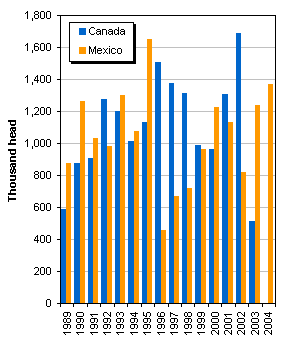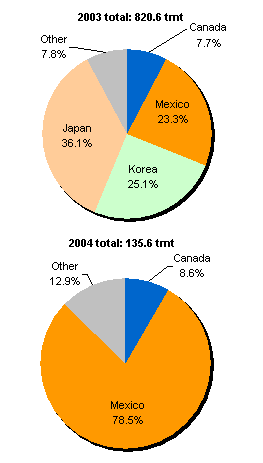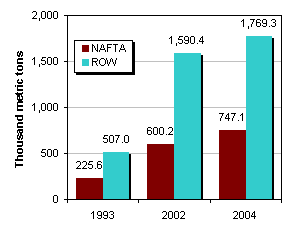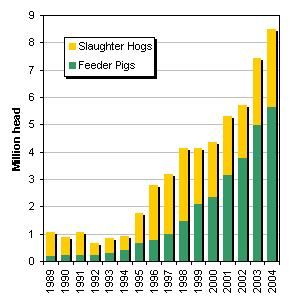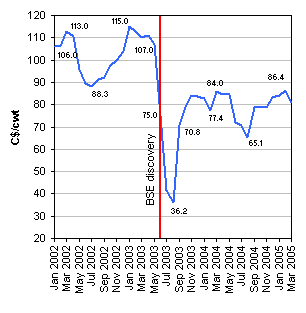|
Since the mid-1980s, the pace of North American food market integration has rapidly accelerated. This was due in part to Mexico entering the General Agreement on Tariffs and Trade (GATT) in 1986, followed by the Canada-US Trade Agreement (CUSTA) in 1989 and the North American Free Trade Agreement (NAFTA) in 1994. The North American food distribution system has become characterized by a well-integrated, efficient, and low-cost supply chain designed to deliver food and agricultural products safely and just in time across the continent. Spurred by CUSTA and NAFTA, agricultural trade and investment in North America have surpassed many expectations. The future of this system in its present form, however, has been challenged by the threat of agroterrorism and recent animal disease outbreaks.
The September 11, 2001, terrorist attacks on the United States resulted in closed borders and uncertainty about the prospects for resuming trade and raised serious doubt about how the United States might respond to another attack or similar event. In the aftermath of the attacks, questions were raised about the vulnerability of the US food supply to intentional contamination and the safety of the US animal and plant populations.
Since then, the United States has implemented legislation to consolidate government agencies to increase security and efficiency. The 2002 Bioterrorism Act was designed to give the Food and Drug Administration more time and information to evaluate the likely risk posed by firms shipping foods to the US market. Despite these changes, the vulnerability of the US food chain, and indeed the integrity of the entire North American food distribution system, remains a concern.
Nearly 90% of US citizens live in food-secure households (United States Department of Agriculture Economic Research Service, 2005). Events that limit the physical availability of food or increase its cost to consumers could disrupt the food chain and reduce the overall level of US food security. There is general consensus that a potential threat to US food security is the intentional contamination of the food supply to cause illness, death, or economic loss. Other factors that could cause disruption to the North American food chain include regulatory changes, such as mandatory country-of-origin labeling (MCOOL), and the use of available trade remedy laws, such as the filing of antidumping and countervailing duty petitions.
This paper reviews developments in North American food market integration and their importance to the US food system. Using the cases of beef cattle, beef, hogs, and pork as examples, implications for trade, foreign direct investment, and food security are examined. How consumers, policy makers, and regulatory authorities respond to these and subsequent events will shape the future and degree of market integration in North America and ultimately US food security.
US-NAFTA Agricultural Trade
The growth in US agricultural trade with NAFTA partners, although well documented, is worthy of mention. US agricultural exports to Mexico have nearly doubled to $8.5 billion since NAFTA was implemented in 1994, while exports to Canada have increased more than fourfold, reaching $10 billion in 2004. Since 1980, agricultural exports to NAFTA partners have expanded 250%. US agricultural imports have also grown, with imports from Mexico more than doubling to $7.3 billion and imports from Canada expanding almost fourfold to $11.5 billion. Agricultural imports from NAFTA trading partners have increased nearly 800% since 1980. In 2004, the United States had an agricultural trade surplus of $1.2 billion with Mexico and a trade deficit of $1.5 billion with Canada.
Also noteworthy is the relative importance of both countries as markets and suppliers. US agricultural exports to NAFTA have increased from about 12.5% of the total in 1989 to 29.7% of total in 2004. The share of US agricultural imports from NAFTA has grown from 23.7% to 34.6% during the same period. As a practical matter, NAFTA now accounts for about one third of US agricultural exports and imports, as opposed to 16% in 1989 and 11% in 1980. The rapid and significant growth in agricultural trade is one of the major contributing factors to the higher degree of market integration within North America.
NAFTA represents a diverse market for commodities as well as high-value products. Nearly two thirds of all US agricultural exports to Mexico are either consumer-ready products or intermediate goods that require some processing before use. Major consumer goods include boxed beef, broilers, pork, and other processed foods. Intermediate goods include powdered milk and vegetable oils. The rest are bulk commodities such as corn, rice, grain sorghum, soybeans, and cotton. When considering US agricultural products to Canada, nearly three fourths are consumer-oriented products and almost 20% are intermediate.
US agricultural imports from Canada and Mexico are composed of 80% consumer-oriented products. Vegetables, fruits, beef, pork, snack foods, and beverages account for the majority of this trade. Seventeen percent of US agricultural imports from NAFTA are intermediate products, with a third to a half of these being live cattle and hogs. Less than 10% are bulk commodities.
Implications of Food Chain Disruptions for Market Integration
The prospects of bioterrorism, coupled with a rash of animal disease outbreaks and continued concerns about the safety of imported foods, have led many to question whether the North American food chain may have reached the highwater mark of market integration. The following indicates that this may not be the case.
North American Cattle and Beef
Cattle and beef have become one of the most highly traded and deeply integrated sectors in the North American market. About 99% of all cattle imported by the United States come from Canada and Mexico, and 98% of all US cattle exports go to those same countries (Figure 1). An average of 821,000 Mexican cattle has come to US pastures and feedlots each year since 1970. Almost all Mexican cattle entering the US market are of stocker/feeder weight. Canada normally ships more than one million head of fed cattle for slaughter to the United States annually. In addition, more than $2.2 billion in beef and beef products are traded among NAFTA partners annually, representing one third of all North American beef trade. The discovery of bovine spongiform encephalopathy (BSE) in Canada and the United States, however, drastically altered some of these relationships.
When BSE was discovered in Canada in May 2003, the international market for Canadian beef and beef cattle closed. The United States, which imported nearly 1.7 million head of Canadian fed steers in 2002 and a half million prior to the discovery in 2003, could no longer rely on those cattle to process. The US market for live Canadian cattle, which was scheduled to reopen March 7, 2005, remains closed due to an injunction filed to stop the implementation of this regulation. Canadian beef, banned by the United States for three months in 2003, is now imported in boneless form and from cattle less than 30 months of age. While awaiting the reopening of the US market for live cattle to reopen, investment in the Canadian beef packing industry has increased, and slaughter capacity is increasing.
Japan, South Korea, Mexico, and Canada accounted for 90% of US beef exports before BSE, and exports represented 9.6% of US beef production. The impact of BSE in the United States, caused in part by the immediate closure of all foreign markets to US beef, was a 20% drop in live cattle prices over a four-day period coupled with a 17% decline in feeder cattle prices. Prices rebounded, however, and set a record high during the summer of 2004. Rapid price recovery was attributed to several factors, including quick action by the USDA to reassure consumers that the US meat supply was safe; low beef supplies because the US was at a low point in the cattle cycle; prohibitions on importing Canadian cattle; and an upswing in domestic consumer demand for meat, driven in part by changes in diet.
Canada and Mexico have reopened their borders to US boneless beef from cattle less than 30 months of age, which currently account for 84% of US beef exports. Although US beef exports have resumed, they are at only 17% of pre-BSE levels and will not recover until Japan and South Korea again allow US beef (Figure 2).
Foreign direct investment (FDI) in North America contributed to increased market integration as well. US FDI in Canadian agriculture expanded from $1.7 billion in 1985, reaching $5.8 billion in 1999. Since then, however, it has fallen to $4.5 billion in 2001. For Mexico the trend was much the same, with US FDI reaching $4.7 billion in 1998, dropping the next year, and recovering to $4.5 billion in 2001.
Within Canada, much of the growth in FDI has been in additional feeding and beef packing capacity as firms have focused on exporting beef instead of cattle in the post-BSE business environment. With 80% of the cattle feeding and packing industry located in the provinces of Alberta and Saskatchewan, those regions are of key importance in assessing the direction of the Canadian cattle industry. The number of cattle on feed (Alberta/Saskatchewan) was 974,403 in April 2005. This is 23% more than one year ago and only 20,000 head below pre-BSE levels. At the same time, the cattle herd was reported to be 15.1 million head, higher than at any time since at least 1960. Cattle marketed reached 203.3 thousand head for the same period—28% above 2004 and the highest since 2000.
Another potential disruption to the North American beef market is the MCOOL provision in the 2002 US Farm Bill. This provision required muscle cuts of beef and pork, fruits, vegetables, peanuts, and seafood products sold in US grocery stores to be labeled as to country of origin beginning October 1, 2004. Implementation for all but seafood was delayed until 2006. There are two issues associated with this regulation. The first issue was the belief that US consumer preference for US beef would decrease US consumption or price of beef from Canadian and Mexican cattle. Second, the need to put all countries on the label might cause processors to decrease their use of foreign cattle so that only US would be used, thereby negating the need for multiple sources on the label. The MCOOL provision, however, has only been enforced for seafood products as a result of funding being withheld by the US Congress for enforcement for other products. There is also proposed legislation to make MCOOL voluntary instead of mandatory.
North American Hogs and Pork
During 2004, NAFTA countries traded 2.5 million metric tons (mmt) of pork, 30% of which occurred within NAFTA (Figure 3). This represents approximately the same percentage of intra-NAFTA pork trade as in 1993, although the magnitude of the trade increased by 243%, reaching 733 thousand metric tons (tmt) in 2004. Although this does not signify an increase in intra-NAFTA trade, it does show that as the overall volume of NAFTA pork trade increased, the intra-NAFTA relationship has remained strong. Accounting for much of the increase in total pork trade among NAFTA countries are US imports from Canada, up 118% from 1993 to 2004, and US exports to Mexico and Canada, up 598% and 680%, respectively, over the same period.
When examining the live hog trade, one major change is the increase in US imports. Since the implementation of CUSTA, Canadian exports of live hogs to the United States have grown from 1.1 million head in 1989 to 8.5 million head in 2004, accounting for all but a few hundred head of US hog imports (Figure 4). Most of this increase has occurred since 1995, when exports were 1.7 million head. Since that time, Canadian exports of fed hogs to the United States has grown 485%, from 1.1 million head to 2.9 million head. Even more dramatic growth has occurred in US imports of feeder pigs from Canada, from 700,000 head in 1995 to 5.6 million head in 2004. The main reason for the large increase in US feeder pig imports is limited hog finishing capacity in Canada when compared to advances in farrowing capacity and efficiency, partially due to strict environmental regulations in Canada.
Since 1994, US hog exports to Mexico have been as erratic as they were prior to NAFTA (albeit at a higher level), particularly since 1998, when exports reached a seven-year high of 207,900 head. Most US hog exports to Mexico have been for slaughter, averaging 86% of the total since the implementation of NAFTA. In 1992, 1997, and 2002, slightly more than one half of US hog exports to Mexico were for breeding. US hog exports to Mexico during 2004 were 138,775 head and accounted for 80% of US exports. Other US hog exports, particularly those to China, Hong Kong, Japan, and Korea, are mainly breeding stock.
The potential for food chain disruption has taken a different form in North American hog and pork trade. The large increase in US hog imports from Canada prompted many in the US pork industry to suspect that Canada was shipping hogs to the United States at a price that was less than fair value (LTFV). In March 2004, the National Pork Producers Council filed a case with the US International Trade Commission (ITC) and the US Department of Commerce (DOC) alleging injury to the US pork industry from these imports. This was the second case filed by the US industry since 1998. Although the DOC agreed that these hogs were entering the United States at LTFV, the ITC concluded that this did not cause "material injury" to the US industry and that the establishment of the US industry had not been "materially retarded." Had there been a finding of material injury or retardation to the industry, an antidumping compensatory tariff would likely been imposed on the importation of Canadian hogs, potentially causing disruption in the US pork market.
Just a year before the US case against Canada, the Mexican pork industry initiated an antidumping case against the imports of pork from the United States. This followed an antidumping case filed by the Mexican industry in 1999 against US slaughter hogs. The hog case resulted in a compensatory duty of $0.351/kg imposed on Mexican imports of US hogs effective October 2000 through May 2003. The pork case, however, ended in May 2004 with no compensatory duties being levied. However, an investigation of imports of US pork hams was initiated immediately following the broader pork case. The final determination on this case has not yet been announced.
What these hog and pork cases indicate is that when combined with animal health, food safety, and other regulatory issues such as MCOOL, there are many potential disruptions to the North American meat food chain. Furthermore, only a few examples have been highlighted here. In pork and hogs, there is also concern about MCOOL, and there are animal health issues. By the same token, there have been antidumping and countervailing duty cases filed in the North American beef cattle industry, by the United States against Canada and Mexico, and by Mexico against the United States. Thus far, however, only the case of North American BSE has caused major disruptions.
The Case of BSE in North America: A Closer Look at Trade Issues and Implications
The short-run industry response to BSE was to concentrate trade and resources within the North American food chain. Although Canadian steer prices initially fell 65% after the Canadian BSE case in May 2003, they have since recovered most of their value, reaching the high $80s (Canadian) in February 2005 before dropping to the low $80s in March (Alberta Agriculture, Food and Rural Development, 2005; Figure 5). Prices also appear to be exhibiting more normal seasonal patterns as well. Price recovery stems from two major market factors. First, consumers did not panic when BSE was found and continued to purchase beef. Second, as soon as the US market was reopened to Canadian beef, meat packers specialized in the export of boneless beef from cattle less than 30 months of age in order to comply with US regulations, thereby increasing the demand for cattle. The value of mature Canadian cows fell by 75% and is still struggling to recover.
US beef exports fell from 820 tmt in 2003 to a mere 136 tmt in 2004. Export prospects for 2005 are not much better, as companies wait for Japan to reopen its market to US beef. Cattle prices did decline in late 2003 and early 2004 but soon recovered their value.
Although beef imports were lower in 2003 due to less Canadian product, overall US imports of beef rose in 2004, with Uruguay setting a record for shipments to the United States with 99,000 tons. Larger supplies of beef also arrived from Australia and New Zealand. The majority of this beef was classified as frozen, boneless trimmings and about 90% lean. It was used to blend with US beef in order to obtain an 80% lean product used for ground meat in grocery and fast food businesses. US imports of Mexican cattle also rose in 2004, reaching 1.37 million head. Imports of Canadian cattle remain banned as of this writing.
It is less clear what may happen over the long run, and much depends on when (or whether) the US market for Canadian cattle reopens and US beef sales to Japan and South Korea resume. What is clear, however, is that Canadian feedlot placements have increased and packing capacity is increasing. Should this trend continue, US imports of Canadian beef will increase, and Canada will be well positioned to respond to market opportunities as more markets for beef reopen. It also appears that Canadian hog exports are set to continue, unless US antidumping or countervailing action slows them. More hogs will likely mean less Canadian pork, a trend that appears to have started in 2003.
In the United States, the cattle herd appears set to rebuild. As this occurs, less imports of beef from Uruguay are likely, especially since it appears higher valued than imported beef from Canada, Australia, or New Zealand. Australia and New Zealand have also responded to market opportunities in Japan in the absence of US beef. About 60% of Australian beef exports went to Japan in 2004, accounting for 47% of Japan's beef imports. Australian feedlots were expected to reach 77% of capacity in late 2004, with a growing share of the beef destined for Japan over the next two years (USDA, 2005a).
US exports of pork and poultry likely will outpace beef during 2005, especially if Japan and South Korea do not open by summer. The US beef industry is set to respond, however, and will attempt to regain lost market share in both countries. Reliance on a larger number of export markets may emerge as a viable long run strategy as exports resume. Spreading market risk across more countries appears to be one way to somewhat mitigate the negative impacts of disease outbreaks and unforeseen events and is likely a sound marketing strategy for the long term.
Mexico appears to be in a cattle herd rebuilding phase. Capital availability and high interest rates may retard achievement of expected gains in herd replacement, especially for smaller ranchers. As long as US cattle prices remain strong, Mexico will respond with increased exports of feeder calves, likely exceeding one million head for the third consecutive year in 2005. It is also likely that some Mexican businesses will consider expanding feedlots and packing plants to avoid animal disease outbreak issues.
Summary and Conclusions
The degree of dependence on trade is an obvious and important variable in determining just how much of an impact an animal disease outbreak or other food chain event will have on trade. Maintaining consumer confidence in science and the integrity of the North American food chain is absolutely critical. It also remains to be seen whether the high degree of integration in the beef cattle industry, specifically among the United States and Canada, will return if the US border is reopened to Canadian cattle. US reliance on Mexico for an ever-growing number of feeder cattle seems to be well established. The question is whether Mexico can sustain these exports over an extended period of time and still rebuild the cattle herd. The discovery of BSE in Mexico would not only be devastating for Mexican cattle producers, but also for Southwestern feedlots, packing plants, and ranchers.
Now that there is increased integration in North American agriculture, adverse events have the potential to create larger disruptions than in the past. BSE is a case in point. Whether North America will return to the previous path of integration in the beef industry, or whether this integration takes a new path as the Canadian beef processing industry grows and focuses on exporting beef, is a crucial issue. As the duration of a disruption grows, the opportunity to return to the pre-BSE levels of trade seems to be slipping away. Protectionist sentiment, coupled with rent seeking, appears to have garnered the attention of policy makers and could derail continued market integration well into the future.
For More Information
Alberta Agriculture, Food and Rural Development. (2005). Weekly Livestock Market Review. Various Issues, January 2004 - March 2005. Available on the World Wide Web: http://www1.agric.gov.ab.ca.
CanFax. (n.d.). Cattle on feed report. Various monthly issues. Available on the World Wide Web: http://www.canfax.ca.
Lloyd, T., McCorriston, S., Morgan, C.W., & Rayner, A.J. (2001, August). The impact of food scares on beef and inter-related meat markets. Paper presented at the annual meeting of the American Agricultural Economics Association, Chicago, IL.
United States Department of Agriculture Economic Research Service. (2005). Food security briefing room. Washington, DC: USDA. Available on the World Wide Web: http://www.ers.usda.gov/Briefing/FoodSecurity/.
United States Department of Agriculture Foreign Agricultural Service. (2005a). Australia livestock and products semi annual 2005 (GAIN report AS5003). Washington, DC: USDA. Available on the World Wide Web: http://www.fas.usda.gov/gainfiles/200502/146118708.pdf.
United States Department of Agriculture Foreign Agricultural Service. (2005b). Mexico livestock and products semi annual 2005 (GAIN report MX5011). Washington, DC: USDA. Available on the World Wide Web: http://www.fas.usda.gov/gainfiles/200501/146118622.pdf.
United States Department of Agriculture Foreign Agricultural Service. (2005c). U.S. internet trade system. Washington, DC: USDA. Available on the World Wide Web: http://www.fas.usda.gov/ustrade.
United States Department of State. (2002). Food security and safety. Economic Perspectives: An Electronic Journal of the U.S. Department of State, 7(2). Available on the World Wide Web: http://usinfo.state.gov/journals/ites/0502/ijee/ijee0502.htm.
United States International Trade Commission. (2005). Live swine from Canada (investigation no. 731-TA-1076 [final]; publication 3766). Washington, DC: USITC. Available on the World Wide Web: http://www.usitc.gov.
|
|
Other articles in this theme:
|
|

